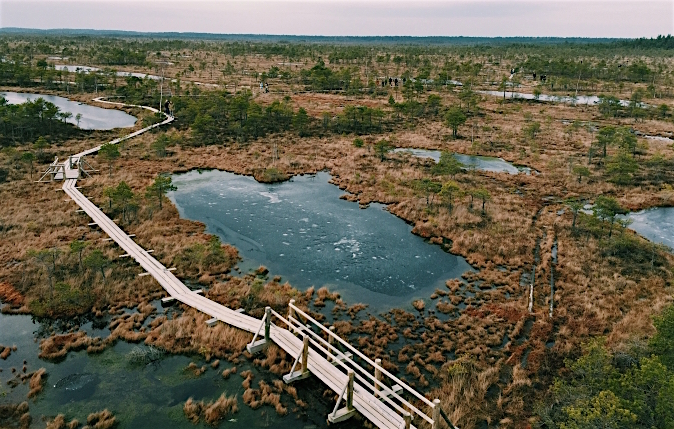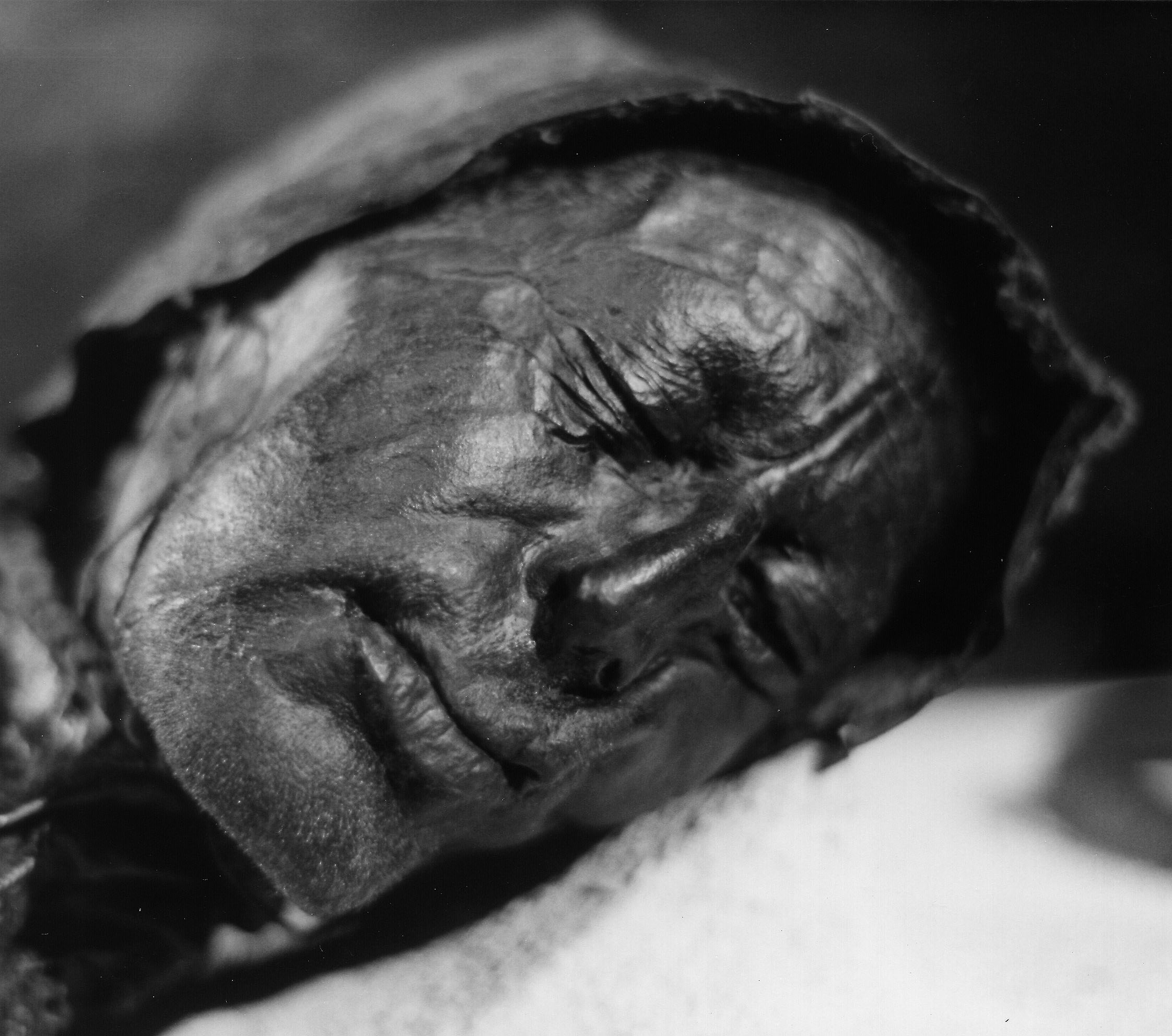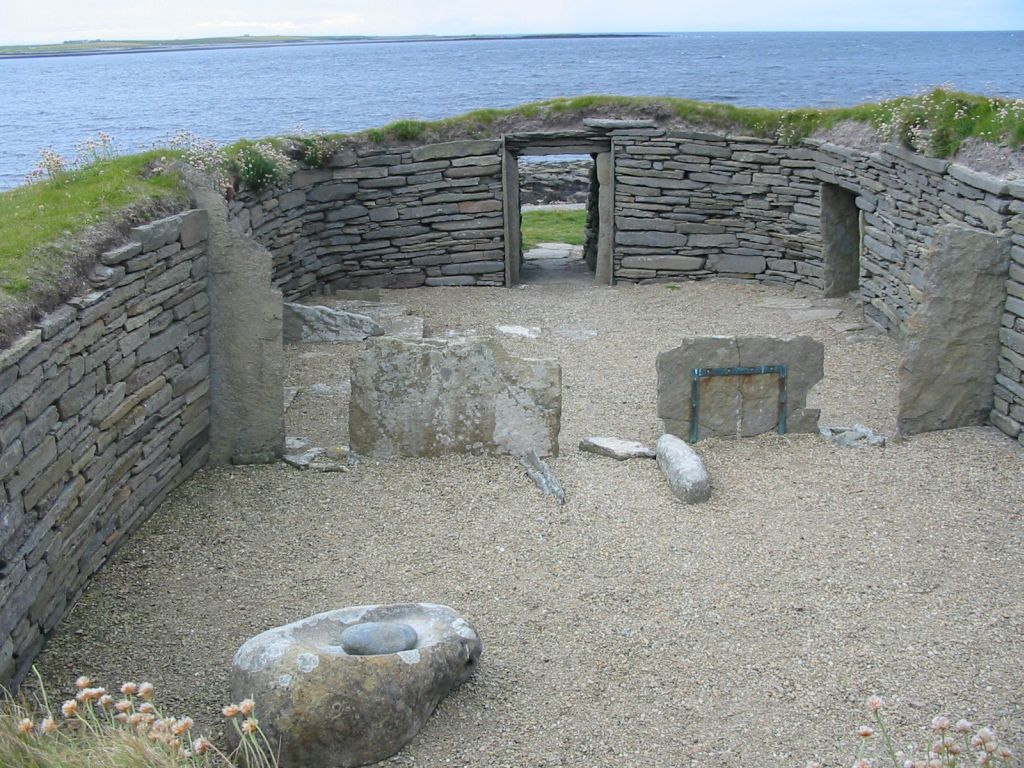|
Gunnister Man
The Gunnister Man is the remains of a late 17th or early 18th century man found by two Shetlanders in a peat bog not far from the junction of the A970 road in Gunnister, Shetland, Scotland. The bog body was found on 12 May 1951 as the men were digging peat for fuel. A stone placed by the Northmavine History Group now marks the find location. Description The body is believed to date from the late 17th or early 18th century. Three coins found in a knitted purse were a 6-Stuiver piece from Nijmegen (Netherlands) dated to 1690, a 2-Stuiver piece from Overijssel dated to 1681 and a Öre from Sweden dating from 1683. The knitted purse found with the body is believed to be the earliest example of two-colour knitting in Shetland. The man was dressed in many woollen clothes, all of which survived burial in the peat in excellent condition. He wore a woollen shirt, a suit of long coat and short wide breeches, and an outer jacket. He had two caps, a pair of gloves and knitted stockings. Hi ... [...More Info...] [...Related Items...] OR: [Wikipedia] [Google] [Baidu] |
Peat Bog
A bog or bogland is a wetland that accumulates peat as a deposit of dead plant materials often mosses, typically sphagnum moss. It is one of the four main types of wetlands. Other names for bogs include mire, mosses, quagmire, and muskeg; alkaline mires are called fens. A baygall is another type of bog found in the forest of the Gulf Coast states in the United States.Watson, Geraldine Ellis (2000) ''Big Thicket Plant Ecology: An Introduction'', Third Edition (Temple Big Thicket Series #5). University of North Texas Press. Denton, Texas. 152 pp. Texas Parks and Wildlife. Ecological Mapping systems of Texas: West Gulf Coastal Plain Seepage Swamp and Baygall'. Retrieved 7 July 2020 They are often covered in heath or heather shrubs rooted in the sphagnum moss and peat. The gradual accumulation of decayed plant material in a bog functions as a carbon sink. Bogs occur where the water at the ground surface is acidic and low in nutrients. In contrast to fens, they derive most of t ... [...More Info...] [...Related Items...] OR: [Wikipedia] [Google] [Baidu] |
Fair Isle Knitting
Fair Isle (/fɛəraɪ̯l/) is a traditional knitting technique used to create patterns with multiple colours. It is named after Fair Isle, one of the Shetland Islands. Fair Isle knitting gained considerable popularity when the Prince of Wales (later Edward VIII) wore Fair Isle jumpers in public in 1921. Traditional Fair Isle patterns have a limited palette of five or so colours, use only two colours per row, are worked in the round, and limit the length of a run of any particular colour. Some people use the term "Fair Isle" to refer to any colourwork knitting where stitches are knitted alternately in various colours, with the unused colours stranded across the back of the work, but this is inaccurate. The term "stranded colourwork" is applicable for the generic technique, and the term "Fair Isle" is reserved for the characteristic patterns of Shetland. Other techniques for knitting in colour include intarsia, slip-stitch colour (also known as mosaic knitting). Technique B ... [...More Info...] [...Related Items...] OR: [Wikipedia] [Google] [Baidu] |
Death In Scotland
Death is the irreversible cessation of all biological functions that sustain an organism. For organisms with a brain, death can also be defined as the irreversible cessation of functioning of the whole brain, including brainstem, and brain death is sometimes used as a legal definition of death. The remains of a former organism normally begin to decompose shortly after death. Death is an inevitable process that eventually occurs in almost all organisms. Death is generally applied to whole organisms; the similar process seen in individual components of an organism, such as cells or tissues, is necrosis. Something that is not considered an organism, such as a virus, can be physically destroyed but is not said to die. As of the early 21st century, over 150,000 humans die each day, with ageing being by far the most common cause of death. Many cultures and religions have the idea of an afterlife, and also may hold the idea of judgement of good and bad deeds in one's life (heaven, ... [...More Info...] [...Related Items...] OR: [Wikipedia] [Google] [Baidu] |
Bogs Of Scotland
A bog or bogland is a wetland that accumulates peat as a deposit of dead plant materials often mosses, typically sphagnum moss. It is one of the four main types of wetlands. Other names for bogs include mire, mosses, quagmire, and muskeg; alkaline mires are called fens. A baygall is another type of bog found in the forest of the Gulf Coast states in the United States.Watson, Geraldine Ellis (2000) ''Big Thicket Plant Ecology: An Introduction'', Third Edition (Temple Big Thicket Series #5). University of North Texas Press. Denton, Texas. 152 pp. Texas Parks and Wildlife. Ecological Mapping systems of Texas: West Gulf Coastal Plain Seepage Swamp and Baygall'. Retrieved 7 July 2020 They are often covered in heath or heather shrubs rooted in the sphagnum moss and peat. The gradual accumulation of decayed plant material in a bog functions as a carbon sink. Bogs occur where the water at the ground surface is acidic and low in nutrients. In contrast to fens, they derive most of th ... [...More Info...] [...Related Items...] OR: [Wikipedia] [Google] [Baidu] |
Bog Bodies
A bog body is a human cadaver that has been naturally mummified in a peat bog. Such bodies, sometimes known as bog people, are both geographically and chronologically widespread, having been dated to between and the Second World War. Fischer 1998. p. 237. The unifying factor of the bog bodies is that they have been found in peat and are partially preserved; however, the actual levels of preservation vary widely from perfectly preserved to mere skeletons. Van der Sanden 1996. p. 7. Unlike most ancient human remains, bog bodies often retain their skin and internal organs due to the unusual conditions of the surrounding area. Combined, highly acidic water, low temperature, and a lack of oxygen preserve but severely tan their skin. While the skin is well-preserved, the bones are generally not, due to the dissolution of the calcium phosphate of bone by the peat's acidity. The acidic conditions of these bogs allow for the preservation of materials such as skin, hair, nails, wool and l ... [...More Info...] [...Related Items...] OR: [Wikipedia] [Google] [Baidu] |
Archaeological Sites In Shetland
Archaeology or archeology is the scientific study of human activity through the recovery and analysis of material culture. The archaeological record consists of artifacts, architecture, biofacts or ecofacts, sites, and cultural landscapes. Archaeology can be considered both a social science and a branch of the humanities. It is usually considered an independent academic discipline, but may also be classified as part of anthropology (in North America – the four-field approach), history or geography. Archaeologists study human prehistory and history, from the development of the first stone tools at Lomekwi in East Africa 3.3 million years ago up until recent decades. Archaeology is distinct from palaeontology, which is the study of fossil remains. Archaeology is particularly important for learning about prehistoric societies, for which, by definition, there are no written records. Prehistory includes over 99% of the human past, from the Paleolithic until the adv ... [...More Info...] [...Related Items...] OR: [Wikipedia] [Google] [Baidu] |
1951 Archaeological Discoveries
Events January * January 4 – Korean War: Third Battle of Seoul – Chinese and North Korean forces capture Seoul for the second time (having lost the Second Battle of Seoul in September 1950). * January 9 – The Government of the United Kingdom announces abandonment of the Tanganyika groundnut scheme for the cultivation of peanuts in the Tanganyika Territory, with the writing off of £36.5M debt. * January 15 – In a court in West Germany, Ilse Koch, The "Witch of Buchenwald", wife of the commandant of the Buchenwald concentration camp, is sentenced to life imprisonment. * January 20 – Winter of Terror: Avalanches in the Alps kill 240 and bury 45,000 for a time, in Switzerland, Austria and Italy. * January 21 – Mount Lamington in Papua New Guinea 1951 eruption of Mount Lamington, erupts catastrophically, killing nearly 3,000 people and causing great devastation in Oro Province. * January 25 – Dutch author Anne de Vries releases the first volume of his children's nove ... [...More Info...] [...Related Items...] OR: [Wikipedia] [Google] [Baidu] |
1951 In Scotland
Events from the year 1951 in Scotland. Incumbents * Secretary of State for Scotland and Keeper of the Great Seal – Hector McNeil until 26 October; then James Stuart Law officers * Lord Advocate – John Thomas Wheatley until November; then James Latham Clyde * Solicitor General for Scotland – Douglas Johnston until November; then William Rankine Milligan Judiciary * Lord President of the Court of Session and Lord Justice General – Lord Cooper * Lord Justice Clerk – Lord Thomson * Chairman of the Scottish Land Court – Lord Gibson Events * 11 April – The Stone of Scone is located in Arbroath Abbey having been stolen by Scottish nationalists. * 12 May – Remains of Gunnister Man found in a peat bog in Shetland. * 18– 26 May – Festival of Britain: Festival Ship ''Campania'' on view in Dundee (King George V Dock). * 25 May–8 September – Festival of Britain: Living Traditions exhibition presented at the Royal Scottish Museum, Edinbur ... [...More Info...] [...Related Items...] OR: [Wikipedia] [Google] [Baidu] |
18th Century In Scotland
The recorded begins with the arrival of the Roman Empire in the 1st century, when the Roman province, province of Roman Britain, Britannia reached as far north as the Antonine Wall. North of this was Caledonia, inhabited by the ''Picti'', whose uprisings forced Rome's legions back to Hadrian's Wall. As Rome finally Roman withdrawal from Britain, withdrew from Britain, Gaels, Gaelic raiders called the ''Scoti'' began colonising Western Scotland and Wales. Prior to Roman times, prehistoric Scotland entered the Neolithic Era about 4000 BC, the Bronze Age about 2000 BC, and the Iron Age around 700 BC. The Gaelic kingdom of Dál Riata was founded on the west coast of Scotland in the 6th century. In the following century, History of Christianity in Ireland, Irish missionaries introduced the previously Pictish religion, pagan Picts to Celtic church, Celtic Christianity. Following Saxon England, England's Gregorian mission, the Pictish king Nechtan mac Der-Ilei, Ne ... [...More Info...] [...Related Items...] OR: [Wikipedia] [Google] [Baidu] |
National Museums Of Scotland
National Museums Scotland (NMS; gd, Taighean-tasgaidh Nàiseanta na h-Alba) is an executive non-departmental public body of the Scottish Government. It runs the national museums of Scotland. NMS is one of the country's National Collections, and holds internationally important collections of natural sciences, decorative arts, world cultures, science and technology, and Scottish history and archaeology. List of national museums * The National Museum of Scotland, comprising two linked museums on Chambers Street, in the Old Town of Edinburgh: ** The Museum of Scotland - concerned with the history and people of Scotland ** The Royal Museum - a general museum encompassing global geology, archaeology, natural history, science, technology and art * The National Museum of Flight, at East Fortune, East Lothian * The National Museum of Rural Life, at Wester Kittochside farm, in South Lanarkshire (previously the Museum of Scottish Country Life, previously the Scottish Agricultural Museu ... [...More Info...] [...Related Items...] OR: [Wikipedia] [Google] [Baidu] |
Gunnister
Gunnister is a small 'abandoned' village at the North-West Mainland in Shetland, Scotland. It is most commonly known for the Gunnister Man - the remains of a man from the late 17th century which were found by some peat cutters in a peat bog not far from the junction of A970 road. The name Gunnister has been suggested to stem from the Old Norse/Old Norwegian ''*Gunna-setr''. References Villages in Mainland, Shetland Northmavine Former populated places in Scotland {{shetland-geo-stub ... [...More Info...] [...Related Items...] OR: [Wikipedia] [Google] [Baidu] |
Sweden
Sweden, formally the Kingdom of Sweden,The United Nations Group of Experts on Geographical Names states that the country's formal name is the Kingdom of SwedenUNGEGN World Geographical Names, Sweden./ref> is a Nordic country located on the Scandinavian Peninsula in Northern Europe. It borders Norway to the west and north, Finland to the east, and is connected to Denmark in the southwest by a bridgetunnel across the Öresund. At , Sweden is the largest Nordic country, the third-largest country in the European Union, and the fifth-largest country in Europe. The capital and largest city is Stockholm. Sweden has a total population of 10.5 million, and a low population density of , with around 87% of Swedes residing in urban areas in the central and southern half of the country. Sweden has a nature dominated by forests and a large amount of lakes, including some of the largest in Europe. Many long rivers run from the Scandes range through the landscape, primarily ... [...More Info...] [...Related Items...] OR: [Wikipedia] [Google] [Baidu] |




.jpg)


